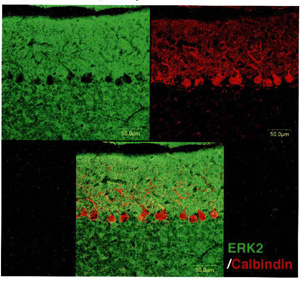 Picture
by Masako Suzuki
Picture
by Masako SuzukiCre-loxP
based conditional gene
deletion.
ERK2(extracellular signal-regulated kinase 2), a one of prototype MAPK(mitogen-activated protein kinase), is deleted using Cre-loxP recombination system in cerebellar Purkinje cells. The Cre-expressing mice generated using L7 promoter and floxed ERK2 mice were used. ERK2 stained in Green is observed entire brain slice except for the Purkinje cells, black spots in left upper picture. Purkinje cell were stained with Calbindin in red. The picture showed the Purkinje cell-specific deletion of ERK2. The null ERK2 KO mice is embryonically lethal but Purkinje cell-specific ERK2 KO mice survives. The conditional gene KO technology allows us to examine the role of ERK2 in adult mice.
The Cre-loxP DNA recombination system, one of a site-specific recombinase technology, is a powerful tool to delete a gene of interest from a specific cell, tissue, or the region of the organs. The Cre-loxP system is now utilized with gene targeting technique to generate the animal with a conditional gene deletion. Successful example is mice. For example, by using the system, embryonically lethal phenotype can be avoided by delay the deletion of the gene of interest until adulthood. This is especially important for the examining the function of central nervous system that requires establishment of neuronal networks and maturation.
Two lines of mice are necessary to generate, a cell specific deletion of a gene X; 1) a mice line expressing a Cre recombinase specifically in the cell of interest (Cre mice), 2) a mice line with the gene of interest flanked by a sequence called loxP (floxed mice). The combination of these two lines mice will yield the specific deletion of the gene X in the cell which express the Cre recombinase. The deletion of the gene absolutely depends on the expression of Cre recombinase. As a result, no Cre recombinase expression, no deletion of the gene X.
The generation of floxed mice is time-consuming but relatively easy in the lab with gene tageting technique for homologous recombination in ES cell. The difficulty is to establish Cre-expressing mice line in the region of or the cells of your interest. Usually, the tissue-specific, or cell-specific promoters are used to generate transgenic mice lines. However, it takes a long time to establish and characterize the integration of Cre gene and the expression of Cre recombinase.
ERK2(extracellular signal-regulated kinase 2), a one of prototype MAPK(mitogen-activated protein kinase), is deleted using Cre-loxP recombination system in cerebellar Purkinje cells. The Cre-expressing mice generated using L7 promoter and floxed ERK2 mice were used. ERK2 stained in Green is observed entire brain slice except for the Purkinje cells, black spots in left upper picture. Purkinje cell were stained with Calbindin in red. The picture showed the Purkinje cell-specific deletion of ERK2. The null ERK2 KO mice is embryonically lethal but Purkinje cell-specific ERK2 KO mice survives. The conditional gene KO technology allows us to examine the role of ERK2 in adult mice.
The Cre-loxP DNA recombination system, one of a site-specific recombinase technology, is a powerful tool to delete a gene of interest from a specific cell, tissue, or the region of the organs. The Cre-loxP system is now utilized with gene targeting technique to generate the animal with a conditional gene deletion. Successful example is mice. For example, by using the system, embryonically lethal phenotype can be avoided by delay the deletion of the gene of interest until adulthood. This is especially important for the examining the function of central nervous system that requires establishment of neuronal networks and maturation.
Two lines of mice are necessary to generate, a cell specific deletion of a gene X; 1) a mice line expressing a Cre recombinase specifically in the cell of interest (Cre mice), 2) a mice line with the gene of interest flanked by a sequence called loxP (floxed mice). The combination of these two lines mice will yield the specific deletion of the gene X in the cell which express the Cre recombinase. The deletion of the gene absolutely depends on the expression of Cre recombinase. As a result, no Cre recombinase expression, no deletion of the gene X.
The generation of floxed mice is time-consuming but relatively easy in the lab with gene tageting technique for homologous recombination in ES cell. The difficulty is to establish Cre-expressing mice line in the region of or the cells of your interest. Usually, the tissue-specific, or cell-specific promoters are used to generate transgenic mice lines. However, it takes a long time to establish and characterize the integration of Cre gene and the expression of Cre recombinase.